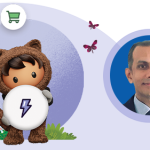Jess O’Reilly is Area Vice President, Sales, ASEAN, at Salesforce. She discusses the shift from personalisation to hyper-personalisation, when it comes to delivering great customer experiences. More from Jess here.
Let’s begin with what we know.
We know that customer experience is king. According to the 2020 State of Connected Customer report, almost 80% of B2C consumers say the experience a company provides is as important as its products or services. That number increases to 85% in the B2B sector.
We also know that personalisation is vital for creating positive customer experiences. More than half (53%) of customers say they feel an emotional connection to the brands they buy from the most.
We see many companies across Asia already using integrated CRM platforms and data insights to meet this demand. More than 60% of marketers have improved personalisation across channels, and 78% say their customer engagement is data driven.
Hyper-personalisation versus personalisation
Hyper-personalisation is the next step forward.
Personalisation had a macro impact on the customer experience. It changed how companies think about customer-centricity. Hyper-personalisation expands these learnings to help companies connect with customers in the micro moments.
For example, personalisation may seek to deliver more relevant marketing content to a customer via their preferred communication channel. Hyper-personalisation seeks to hold a one-to-one conversation with each customer, across all channels.
The road to hyper-personalisation
Customer data fuels hyper-personalisation. Companies must understand their customers’ purchasing behaviour in order to anticipate their next need. But it’s not enough to simply collect and store customer data.
Companies must use data to create a complete 360-degree customer view that seamlessly integrates with legacy systems across the organisation. This is known as a single source of truth, and it’s vital to achieve hyper-personalisation.
Zenyum is one company that has successfully implemented hyper-personalisation. After launching in Singapore in 2018, the smile cosmetics company rapidly expanded into Malaysia, Thailand, Hong Kong, and Vietnam.
“We are targeting a huge market of 600 million people, but in the end, we still want to call every customer to guide them through their smile journey,” says Julian Artopé, CEO of Zenyum.
That is hyper-personalisation. To get there, the company turned to Salesforce and the Customer 360 platform to create a single source of truth. This enables Zenyum’s Customer Success and Customer Care Executives to provide hyper-personalised customer journeys as they move seamlessly between sales and service functions.
“The data gathered through Salesforce helps us check in on every customer as they progress through their Zenyum journey, from the initial pre-assessment to the completion of their treatment,” explains Muhammad Shafeeq, Head of Customer Success (Singapore & Malaysia) at Zenyum.
“Each customer receives highly personalised communication from their private Customer Success and Customer Care Executives, who can now lead them through their entire smile journey.”
How to scale hyper-personalisation
It’s one thing to provide hyper-personalised journeys to a handful of customers. It’s quite another to scale it across a customer base that spans multiple countries, languages, and demographics.
A CRM system that is well-integrated with core operational systems can help. The various departments also need to be connected on the CRM, so that everyone shares a complete view of the customer.
This was certainly a challenge Zenyum faced — and conquered. Artopé explains that the company’s legacy customer relationship management (CRM) software was failing to provide the data insights that enable hyper-personalisation.
“Our system could only give us a basic overview of the total funnel size,” he says. “At the same time, we forced our customers into our channels instead of enabling them to communicate with us however they would like to.”
Customer 360 changed this. Zenyum used it to create an integrated personalisation pipeline. This enables the company’s Customer Success and Customer Care Executives to engage with customers on a one-to-one basis across all communication channels and throughout all stages of the customer journey.
“We needed better reporting options that would allow us to dive deeper into the data and better understand our customers across the seven markets that we are operating in,” Artopé explains. “Salesforce enabled us to create a smoother Zenyum journey and connect more personally with our customers.”
The hyper-personalisation imperative
The need for a single view of the customer may not be news to many companies. According to a Forrester research report, 80% of companies say they would gain from a CRM that provides a single source of truth. Yet, only 25% of companies currently have this capacity.
Customer experience in the future will be hyper-personalised. Without a CRM as a single source of truth, it is difficult for businesses to create hyper-personalised customer experiences. To get started on your hyper-personalisation journey, tune into our Customer 360 webinar on demand, or read more about the Customer 360 platform.

























